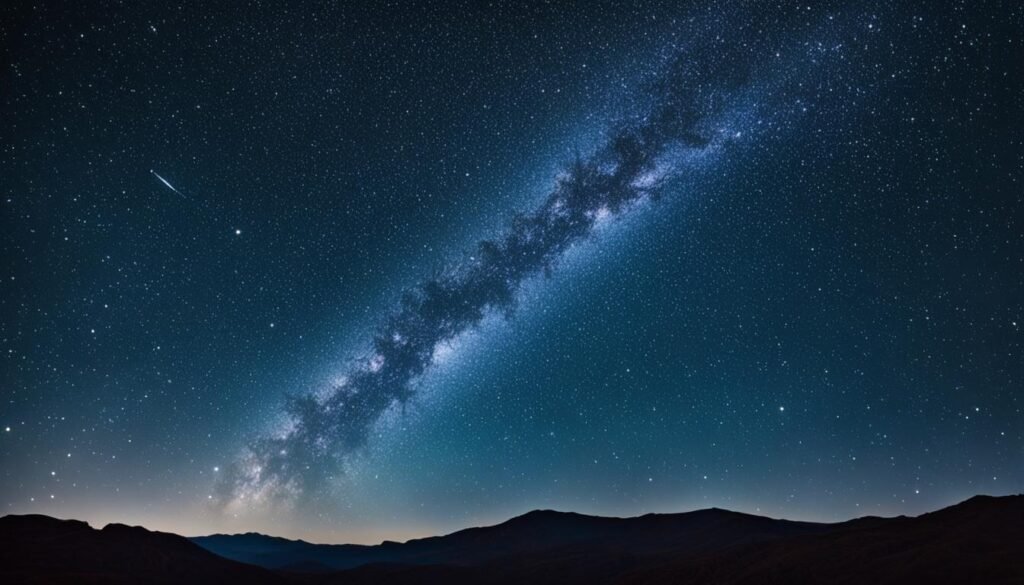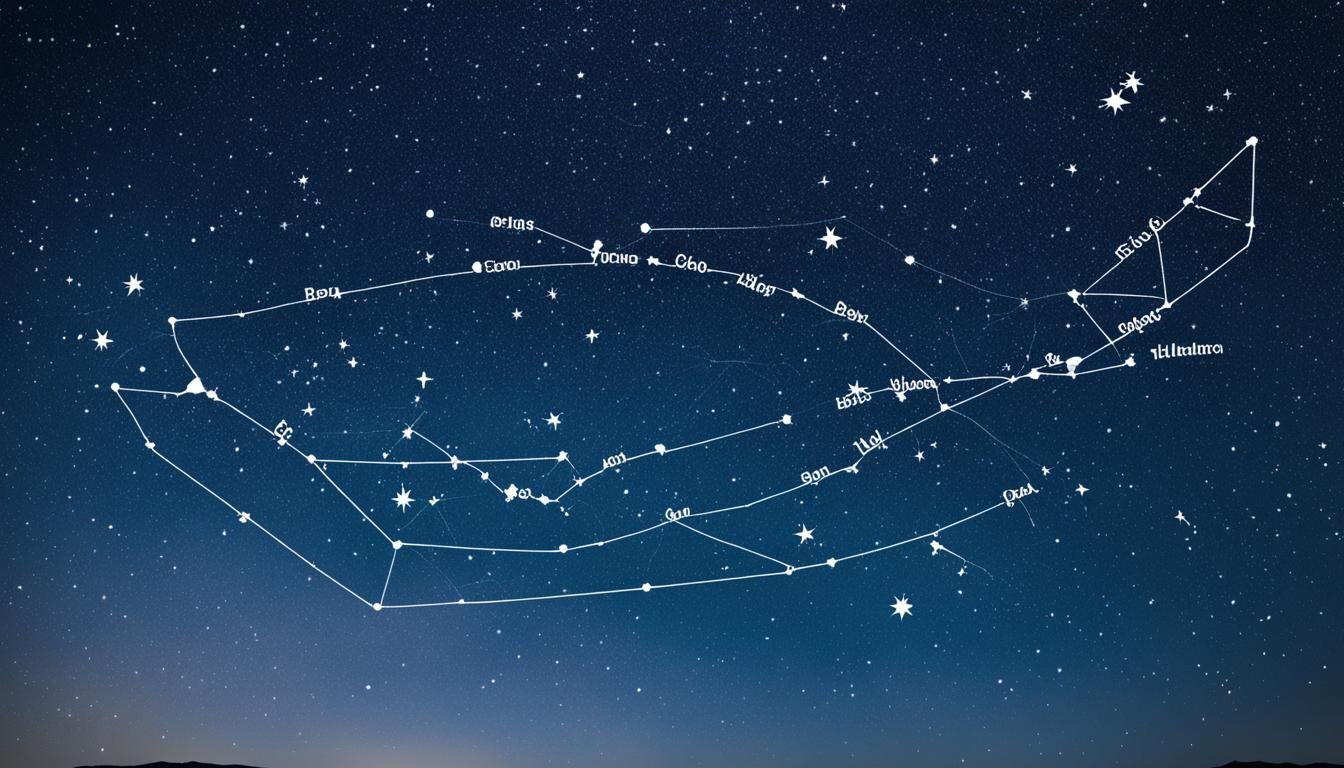| Genitive | |
| Abbreviation | |
| Pronunciation | |
| Main Stars | |
| Brightest Star | |
| Right Ascension | |
| Declination | |
| Sq. Deg. Area | |
| Crosses Meridian | |
| Visible Lat. Range |
Within the vast expanse of the cosmos, the Constellation Hydrus offers a celestial spectacle reserved for the vigilant eyes peering into the southern hemisphere’s night sky. Not to be confused with its larger counterpart Hydra, this “male water snake” is soaked with a rich tapestry of Hydrus astronomy lore, where sailors once charted their course by its starry curve. Even if your passion for the heavens is newly kindled, the intriguing Hydrus constellation facts, the unique Hydrus star map, and the elegant Hydrus star pattern are sure to draw you into its age-old tradition of exploration and discovery.
Key Takeaways
- Hydrus Constellation serves as a guidepost in southern hemisphere astronomy.
- The constellation has a rich history beginning with Dutch navigators and astronomers.
- Hydrus is known for its distinct star pattern that is separate from the constellation Hydra.
- Its best visibility occurs from late October through mid-December each year.
- Various celestial objects reside within Hydrus, despite its lack of ties to classical mythology.
- Understanding the Hydrus star map is crucial for nighttime navigation and stargazing.
Exploring the History of Constellation Hydrus
As you delve into the rich tapestry of the night sky, your attention is drawn to the Hydrus celestial region, a constellation of notoriety and heritage. The Hydrus star constellation holds a story that transcends time, from its birth in the 16th century through to its modern recognition.
A Glimpse into the Discoveries of Petrus Plancius and Johann Bayer
At the helm of Hydrus constellation history are Dutch navigators Frederick de Houtman and Pieter Dirkszoon Keyser, whose celestial observations paved the way for the initial mapping. It was cartographer Petrus Plancius who first depicted Hydrus, and it was later immortalized in print within Johann Bayer’s celebrated star atlas, Uranometria. These significant contributions marked the Hydrus constellation’s official inauguration into astronomical literature and stargazers’ consciousness.
Hydrus in the Dutch Navigators’ Chronicles
Maritime explorations brought more than just new lands and cultures to the Dutch sailors; it also introduced them to the celestial sights of the southern skies. The uniquely distinct pattern of Hydrus was noted as separate from its larger counterpart Hydra, due to the Milky Way that stands between them, and its proximity to Eridanus and Orion. These descriptions from the sails of discovery further encouraged astronomers to distinguish and study this constellation.
The Evolution of the Constellation’s Identification and Naming
The evolution of Hydrus was not merely a matter of charting stars but also of nomenclature and identity. In Nicolas Louis de Lacaille’s planisphere, Hydrus was referred to as l’Hydre Mâle to distinguish it from the female water-snake represented by Hydra. Over the years, this constellation underwent refinement and recognition by the astronomical community when in 1922, the International Astronomical Union (IAU) officially adopted ‘Hyi’ as its abbreviation and solidified its place in the celestial catalogs.
| Event | Contributor(s) | Impact on Hydrus |
|---|---|---|
| 16th-century Observations | Frederick de Houtman, Pieter Dirkszoon Keyser | Basis for the depiction and inclusion in star maps |
| Introduction in Uranometria | Johann Bayer | Popularized Hydrus and offered a precise astronomical framework |
| Refinement of Constellation | Nicolas Louis de Lacaille | Introduced a distinct name and reassigned stars to refine Hydrus |
| Official Recognition | International Astronomical Union | Standardized naming as ‘Hyi’ and cemented its astral identity |
The Celestial Position and Visibility of Hydrus
With a presence that enlivens the celestial sphere, the Hydrus star cluster is a marvel to behold. This southern sky jewel is neatly tucked away among the stars, presenting a delightful challenge for anyone interested in spotting Hydrus. Your celestial journey to uncover this constellation will take you deep into the heart of the southern hemisphere.
A Guide to Spotting Hydrus in the Southern Hemisphere
Whether you are an amateur astronomer or a seasoned stargazer, locating the Hydrus constellation is a rewarding experience. Hydrus occupies the first quadrant of the southern sky and is observable between latitudes +8° and -90°. As night falls and the stars begin to dot the sky, remember that Hydrus finds itself hidden to those in the northern latitudes but shines brightly for observers further south.
Hydrus’ Relation with Nearby Constellations and Landmarks
The constellation not only stands in relative isolation but also participates in a cosmic dance with neighboring constellations. Sharing the same celestial sphere are the brilliant Dorado and Tucana, along with the mysterious winding river, Eridanus. As you venture to capture the essence of Hydrus, you’ll find it nearing the south celestial pole, revealing more of its splendor the closer you get to the pole. Learning to spot Hydrus amongst the southern sky’s stars enhances your night-sky navigation skills, allowing you to unlock the secrets held within this glittering expanse.
Constellation Hydrus: Stars of Magnitude and Mystery
When you cast your eyes upon the southern celestial sphere, it is impossible to overlook the Hydrus star constellation, a tapestry of stellar marvels. Although it lacks the Messier objects and meteor showers that adorn other constellations, Hydrus harbors a luminous collection of stars, each with its own tale of cosmic intrigue.
At the helm is Beta Hydri, the brightest star within the Hydrus constellation. With an apparent magnitude of 2.80, this celestial beacon once served as the closest bright star to the South Pole around 150 BC. It has caught the attention of astronomers who speculate that it may be accompanied by a substellar companion.
Not to be outshone, Alpha Hydri, also known as the Head of Hydri, glimmers as the second brightest jewel of this constellation. Pursuing closely is Gamma Hydri, distinguished by its captivating red hue. These stars, Alpha and Gamma, play essential roles in outlining the mythic form of the water snake across the night sky.
Beyond these luminous anchors, the Hydrus constellation boasts other noteworthy stars. Delta Hydri, for example, is a fascinating white dwarf, while Epsilon Hydri stands out as an impressive blue-white giant. Together with Nu Hydri and Zeta Hydri, they add a luster to this southern constellation that is sure to enthral those who seek celestial beauty.
- Beta Hydri: Brightest star in Hydrus, possibly with a companion
- Alpha Hydri: The ‘Head’ of Hydri, second in brightness
- Gamma Hydri: A radiant red star enriching Hydrus’s array
- Delta Hydri: A white dwarf, offering a glimpse into stellar evolution
- Epsilon Hydri: A blue-white giant dwarfing our own Sun
Without the fanfare of brighter clusters, Hydrus invites you to delve deeper into the cosmos to uncover its subtler beauty. Scintillating and serene, it is a constellation that rewards those who patiently observe the heavens.

Astronomical Wonders Within Hydrus
As you journey through the Hydrus celestial region, you’ll find its sparse array adorned with fascinating deep sky objects in Hydrus and majestic Hydrus exoplanetary systems. These celestial features offer a window into the vastness of the universe and stand as a testament to the complexity of our cosmic neighborhood.
Discovering Deep Sky Objects — From Spiral Galaxies to Globular Clusters
Among the myriad of stars, the constellation of Hydrus hosts some of the most elusive yet captivating deep sky objects. NGC 1466, a dense globular cluster, is a treasure trove of RR Lyrae variable stars, offering insights into the dynamics of globular cluster evolution. Similarly, the whirl of the spiral galaxy NGC 1511 evokes wonder with its elegant arms wrapping around a luminous core.

Perhaps the most enigmatic of these is IC 1717, a galactic phantom that has intrigued astronomers since its initial sighting by John Louis Emil Dreyer. Its now-invisible presence close to Eta-2 Hydri leaves us pondering its fate – was it a supernova that vanished into the cosmos, or was it an error that time erased?
The Remarkable Exoplanetary Systems of Hydrus
The Hydrus constellation not only amazes with its deep sky objects but also with its role as host to an exquisite collection of exoplanetary systems. Foremost among these is the HD 10180 system, which mirrors the architectural blueprint of our very own Solar System. Lined with a sequence of planets, HD 10180 invites us to consider the potential to uncover Earth-like worlds among these far-reaching systems.
- **NGC 1466:** Rich in variable stars, this cluster serves as a cosmic laboratory.
- **NGC 1511:** A testament to the grandeur of spiral galaxies.
- **IC 1717:** A reminder that the universe is full of mysteries waiting to be solved.
- **HD 10180 System:** An exoplanetary system that could be the key to finding another Earth.
With the starlit backdrop of the Hydrus celestial region, these astronomical marvels inspire endless curiosity and the relentless pursuit of knowledge. As you gaze upon these deep sky objects in Hydrus and contemplate the complexity of the Hydrus exoplanetary systems, you’re participating in a timeless human tradition of looking upwards and wondering at the vastness of the universe.
Mapping Out Hydrus Star Constellation
As you immerse yourself in the art of astronomy, the Hydrus constellation mapping offers a celestial guide unlike any other. Starring in the cosmic theater, the Hydrus star map depicts an alluring spectacle, especially designed for the southern observers. By understanding this nocturnal canvas, you unlock the secrets to a constellation that has guided explorers and fascinated astronomers for centuries.
Begin your journey with Beta Hydri, known for its significant place near the southern celestial pole. This luminous star is not just a point in the sky but a beacon for celestial navigation. Surrounding it, the stars such as Alpha and Gamma Hydri add a three-dimensional aspect to the pattern, making the Hydrus constellation a vivid and approachable entity from the Earth.
Let’s delve into a table that further elucidates the stars comprising the constellation of Hydrus:
| Star Name | Magnitude | Right Ascension | Declination |
|---|---|---|---|
| Beta Hydri | 2.80 | 00h 25m 45s | −77° 15′ 15″ |
| Alpha Hydri | 2.86 | 01h 58m 46s | −61° 34′ 12″ |
| Gamma Hydri | 3.24 | 03h 47m 14s | −74° 14′ 20″ |
| Delta Hydri | 4.09 | 02h 21m 45s | −68° 39′ 34″ |
| Epsilon Hydri | 4.11 | 03h 00m 52s | −68° 18′ 03″ |
To truly appreciate the nuances of the Hydrus constellation mapping, take note of the reference points like the Small Magellanic Cloud and the bright star Achernar. These celestial landmarks serve not only as a guide to finding Hydrus but as stepping stones to further cosmic explorations, stitching together the Southern Hemisphere’s starry cloak with threads of light.
With these insights, your grasp on the Hydrus star map transitions from a mere celestial chart to a personal roadmap of the skies; an authoritative guide enabling your own discoveries amidst the southern stars.
The Mythological Void of Hydrus
In the grand auditorium of the night sky, where celestial myths and constellation narratives are often woven from the threads of ancient lore, Hydrus presents a curious exception. As you explore the cosmos, delving into stories of gods and heroes, you may discover that Hydrus mythology stands in stark contrast to its stellar neighbors. This southern constellation, rather than drawing from the myth-laden waters of Greek or Roman traditions, charts a course of recent historical origins rooted in the practical observations of seafaring navigators.
The absence of myth in Hydrus does not diminish its allure but rather emphasizes its unique narrative that aligns with the observational science that defines modern astronomy. With the constellation serving as a guidepost for Dutch mariners, its place among the stars was etched not by the fanciful musings of poets but by the meticulous recordings of celestial cartographers. The scientific pursuit, intrinsic to the discovery and documentation of Hydrus, reflects the constellation’s pragmatic inception and the exploratory spirit of the sailors who first mapped its stars.
As you regard the constellation’s place in the sky, it’s worth appreciating that the modernity of Hydrus within the astral landscape highlights a living narrative. The constellation continues to evolve, free from the constraints of established lore, inviting us to add new chapters to its history. In a universe teeming with celestial myths, Hydrus stands as a testament to the ongoing human quest for knowledge, reminding us that the stories we see in the stars are as varied and infinite as the cosmos itself.
FAQ
What is the Constellation Hydrus known for?
The Constellation Hydrus is known as “the male water snake” for its Latin name translation and it’s uniquely modern astronomical identity. Unlike the larger constellation Hydra, Hydrus is a small constellation located in the southern sky, known for its close proximity to the south celestial pole and its surrounding Magellanic Clouds.
Who discovered the Constellation Hydrus?
Dutch astronomer Petrus Plancius is credited with the introduction of the Constellation Hydrus. It was first depicted on a celestial globe in 1597, after observations from Dutch navigators, and later included in Johann Bayer’s influential star atlas Uranometria in 1603.
How can I find the Constellation Hydrus in the sky?
Hydrus is located in the first quadrant of the southern hemisphere (SQ1) and is best spotted from locations in the southern hemisphere, specifically between latitudes +8° and -90°. Ideal viewing times are late October to mid-December. Look for it near the Small Magellanic Cloud and under the constellation Eridanus.
What are the brightest stars in the Constellation Hydrus?
The brightest stars in the Hydrus constellation are Beta Hydri, with an apparent magnitude of 2.80, Alpha Hydri, and Gamma Hydri. These stars provide a guide to mapping the constellation’s shape in the southern sky.
Are there any deep sky objects in the Constellation Hydrus?
Yes, although sparse, Hydrus contains several notable deep sky objects like NGC 1466, a globular cluster, and the spiral galaxy NGC 1511. Moreover, it’s home to the fascinating exoplanetary system HD 10180, likened to our own Solar System in the number and structure of its planets.
Is there a mythology associated with the Constellation Hydrus?
Unlike most other constellations, Hydrus does not have a mythology tied to it. It was cataloged by navigators in the 16th century and reflects the age of exploration more than mythological stories.
What differentiates the Constellation Hydrus from Hydra?
Hydrus and Hydra are often confused due to their similar names. However, they are distinct constellations with Hydrus being much smaller and found in the southern celestial hemisphere, while Hydra is the largest constellation and primarily lies in the northern hemisphere. Additionally, Hydrus has its own set of stars and deep sky objects separate from those associated with Hydra.






